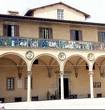|
 |
Pistoia
Although it is not yet as visited as other towns in
Tuscany, Pistoia presents a well-preserved and charming
medieval city inside the old walls. The large Piazza del
Duomo is lined with attractive original buildings, and is
the setting (in July) of the Bear Joust (Giostra dell'Orso),
when the best horsemen of the districts of the town tilt
with lances at a target held up by a dummy shaped like a
bear.
|
 |
The savagery of the
ancient inhabitants of Pistoia lives on in the weapon that
takes its name from their city (though the word "pistol" originally
referred to a type of dagger). But the idea of savagery is
unfair; this city is an architectural feast, especially the
unforgettable Ospedale del Ceppo, with its ornate terracotta
frieze and medallions. |
|
Historically the town was a Roman colony in the 6th
century BC, and in 62 BC Catiline and his fellow conspirators
were slain nearby. In 1254 Ghibelline Pistoia was taken over
by Guelph Florence, but supposedly resulted in the division
of the Guelphs into "Black" and "White" factions. Pistoia
remained a Florentine holding except for a brief period in
the 14th century, when Castruccio Castracani captured it for
Lucca, and was officially annexed to Florence in 1530. |
| |
|
 |
Geographically Pistoia is in the middle of the Tuscan
province of the same name, is 67 meters above sea level. It
is located on a wide plain on the Ombrone River and lies between
Monte Albano and the slopes of the Appenines. The city, rich
in monuments and medieval architecture, is a vivacious cultural
center. It houses the Academy of Organ Music. Its economic
development is tied, above all, to plant and flower cultivation,
to nearby thermal establishments, and to industry in general.
|
|
